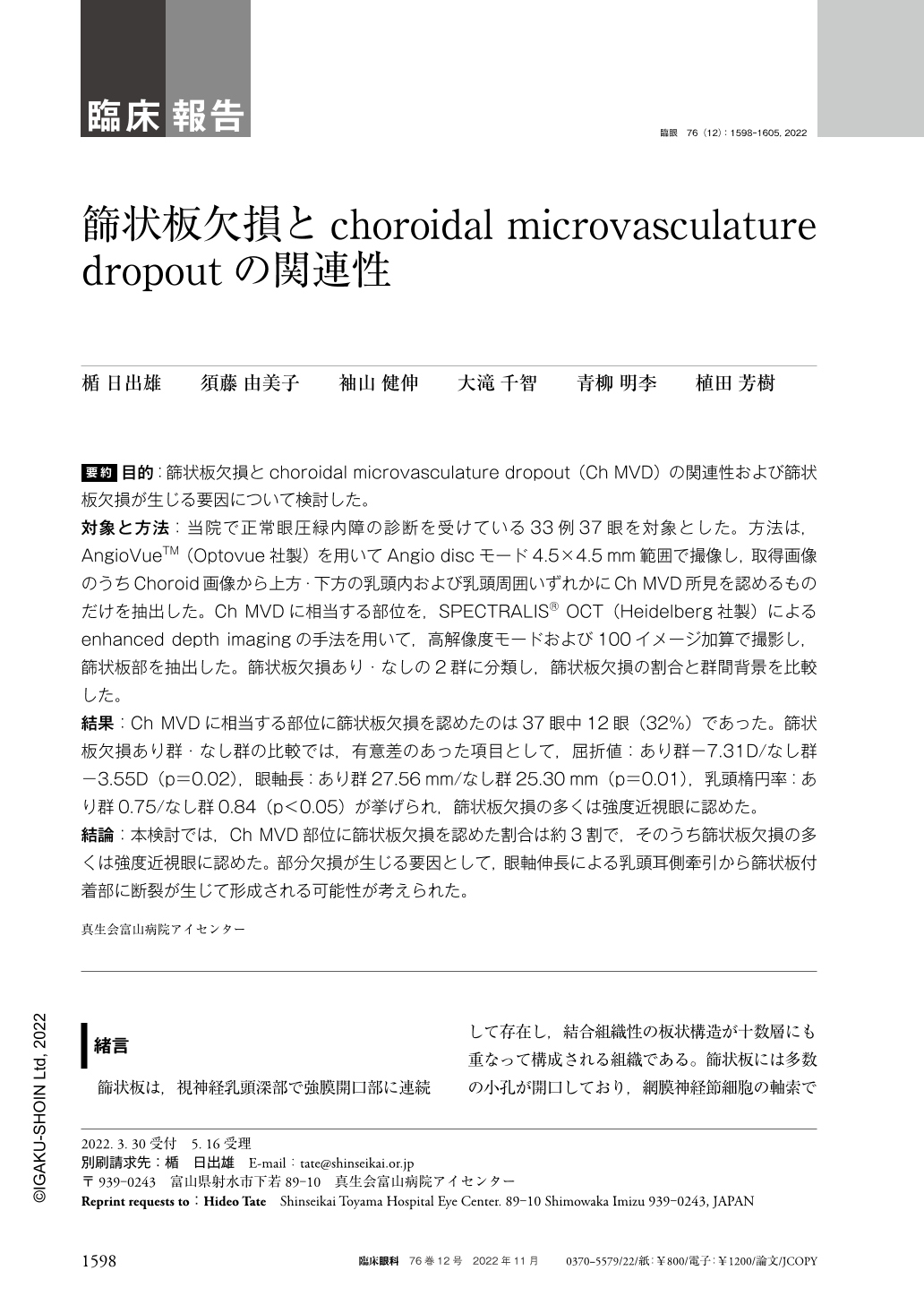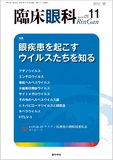Japanese
English
- 有料閲覧
- Abstract 文献概要
- 1ページ目 Look Inside
- 参考文献 Reference
要約 目的:篩状板欠損とchoroidal microvasculature dropout(Ch MVD)の関連性および篩状板欠損が生じる要因について検討した。
対象と方法:当院で正常眼圧緑内障の診断を受けている33例37眼を対象とした。方法は,AngioVueTM(Optovue社製)を用いてAngio discモード4.5×4.5mm範囲で撮像し,取得画像のうちChoroid画像から上方・下方の乳頭内および乳頭周囲いずれかにCh MVD所見を認めるものだけを抽出した。Ch MVDに相当する部位を,SPECTRALIS® OCT(Heidelberg社製)によるenhanced depth imagingの手法を用いて,高解像度モードおよび100イメージ加算で撮影し,篩状板部を抽出した。篩状板欠損あり・なしの2群に分類し,篩状板欠損の割合と群間背景を比較した。
結果:Ch MVDに相当する部位に篩状板欠損を認めたのは37眼中12眼(32%)であった。篩状板欠損あり群・なし群の比較では,有意差のあった項目として,屈折値:あり群−7.31D/なし群−3.55D(p=0.02),眼軸長:あり群27.56mm/なし群25.30mm(p=0.01),乳頭楕円率:あり群0.75/なし群0.84(p<0.05)が挙げられ,篩状板欠損の多くは強度近視眼に認めた。
結論:本検討では,Ch MVD部位に篩状板欠損を認めた割合は約3割で,そのうち篩状板欠損の多くは強度近視眼に認めた。部分欠損が生じる要因として,眼軸伸長による乳頭耳側牽引から篩状板付着部に断裂が生じて形成される可能性が考えられた。
Abstract Purpose:To investigate the relationship between lamina cribrosa defect and choroidal microvasculature dropout(Ch MVD)and the factors that cause lamina cribrosa defect.
Subjects and Methods:Thirty-three patients(37 eyes)diagnosed with normal tension glaucoma at our hospital were included in this study. The study methodology was as follows:AngioVueTM(Optovue)was used to image the 4.5×4.5 mm range in the Angio disc mode, and we extracted only those images that showed Ch MVD in either the superior or inferior intrapapillary and peripapillary areas of the choroid images. The area corresponding to the Ch MVD was imaged using enhanced depth imaging technique by SPECTRALIS® OCT(Heidelberg)in high resolution mode and 100 image addition to extract the lamina cribrosa defect. We classified the patients into two groups, with and without lamina cribrosa defect, and compared the percentage of partial defect and the background between the groups.
Results:Lamina cribrosa defects in the area corresponding to Ch MVD were found in 12 of 37 eyes(32%). In the background comparison between the groups with and without lamina cribrosa defects, significant differences were observed in refraction value:−7.31D in the group with lamina cribrosa defects and −3.55D in the group without lamina cribrosa defects(p=0.02);in axial length:27.56 mm in the group with lamina cribrosa defects and 25.30 mm in the group without lamina cribrosa defects(p=0.01);and in optic nerve ellipticity:0.75 in the group with lamina cribrosa defects and 0.84 in the group without lamina cribrosa defects(p<0.05). The majority of the lamina cribrosa defects were found in eyes with high myopia.
Conclusions:In this study, the percentage of patients with lamina cribrosa defects at the Ch MVD site was about 30%, and most of the lamina cribrosa defects were found in high-myopic eyes. The partial defects were thought to be caused by a tear in the attachment of the lamina cribrosa plate from the temporal traction of the optic disc due to ocular axis elongation.

Copyright © 2022, Igaku-Shoin Ltd. All rights reserved.


